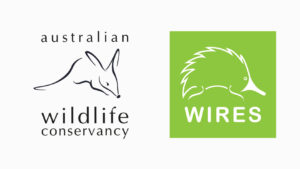
Australian Wildlife Conservancy (AWC) and Wildlife Information, Rescue and Education Service (WIRES) are proud to announce the establishment of an exciting new partnership. Thanks to the incredible support WIRES received from the global community to assist wildlife, WIRES is investing over $1.6 million in AWC’s major bushfire recovery projects that will see at least two of Australia’s most endangered mammals saved from extinction.
WIRES Chief Executive, Leanne Taylor, said “The catastrophic bushfires last summer have been devastating for Australia’s wildlife. We are proud to partner with AWC and support major projects aimed at restoring native wildlife populations that have been driven to the brink of extinction.”
More than 1.25 billion animals are estimated to have perished in the bushfires last summer. Some species, like the Kangaroo Island Dunnart, are lucky to have survived – helped along by the timely intervention of organisations like AWC. More needs to be done if we are to avoid adding additional species to Australia’s mammal extinction record – already acknowledged as the worst in the world.
“This is a great step forward for conservation,” AWC Chief Executive, Tim Allard, said. “We are excited to partner with an organisation that is as passionate as we are about protecting Australia’s threatened wildlife and seeing their populations restored. This partnership with WIRES represents an incredibly exciting opportunity to generate great outcomes for Australia’s wildlife and turn back the tide of species’ declines in this country.”
Major AWC projects WIRES is supporting include:
Bushfire Recovery
Under the partnership, WIRES will provide a substantial contribution towards AWC’s work to save the Kangaroo Island Dunnart from extinction. We will be establishing a 370-hectare feral predator-free critical refuge on the island, known as the Western River Refuge. Stage 1 of this project, a 13.8 hectare feral predator-free area, has already been completed. The Kangaroo Island Western River Project is a collaboration between AWC, private landholders, the Doube family, and Kangaroo Island Land for Wildlife (KI LfW) to save the KI Dunnart from extinction and protect six additional threatened species.
Before the bushfires, the Kangaroo Island Dunnart was already on the precipice of extinction. The devastating fires of January 2020, that razed much of south-eastern Australia, saw this little Australian marsupial propelled to the top of the Commonwealth Government’s most endangered mammals list after 95 per cent of its habitat was destroyed.
AWC CEO Tim Allard says it is critical to expand the Kangaroo Island fire recovery program.
“The Federal Government acknowledges the Kangaroo Island Dunnart population hangs by a thread, with so few individuals left that it is likely to be the next Australian mammal to go extinct. WIRES and AWC are united – we simply can’t allow that to happen on our watch,” Mr Allard said.
“Stage 1 has successfully secured a small area of the Dunnart’s remaining habitat, but to ensure the survival of the species as a whole we need to rapidly expand the area. Time is against us” Allard said “but with WIRES support, we’ve been able to crack on with construction of Stage 2. It’s a very significant project: not only will the KI Dunnart be saved from extinction, but a further six threatened species will be protected as well. By working together we’ll be able to secure populations of Southern Brown Bandicoot, Glossy Black Cockatoo, Southern Emu Wren, Kangaroo Island Short-beaked Echidna, Heath Goanna and Bassian Thrush – and that’s worth celebrating.”
WIRES are also providing generous support for AWC’s bushfire recovery programs in NSW. “We’re joining forces with AWC to find large areas of habitat where some of Australia’s most iconic species – like the Koala – can enjoy a more secure future” Taylor said. “We’re also proud to support AWC’s work to undertake ecological assessments in the wake of the bushfires, provide advice to local landholders, and carry out research that we hope will lead to the development of ecologically-friendly burning regimes for south-east Australia.”
AWC already carries out Australia’s largest non-government fire management program across 7.5 million hectares of northern Australia, from Cape York in Queensland to the Kimberley coast of Western Australia.
“Not only will we incorporate results and lessons learnt from our northern fire management program, we will work with local Traditional Owners and learn from their knowledge of Country,” Mr Allard said.
Saving the endangered Northern Bettong from extinction
Previously a NSW-centric organisation, WIRES is now expanding its geographic reach. Under the partnership, WIRES is contributing towards AWC’s project to save another of Australia’s most endangered mammals – the rare Northern Bettong – from extinction. Ranked as a ‘critical priority’ by the Queensland Government, fewer than 1,000 Northern Bettongs remain in the world.
Northern Bettongs are one of a suite of species known as “ecosystem engineers” because of the vital role they play in ecosystem processes such as plant and fungi dispersal. Working in collaboration with the Queensland Government, AWC has already undertaken extensive research into this small and delicate macropod. Inspired by the results, AWC will now partner with WIRES to create a fenced, feral predator-free area at its Mount Zero-Taravale Wildlife Sanctuary, where this keystone species will be restored.
“Mount Zero-Taravale Wildlife Sanctuary is known to have supported a population of Northern Bettongs that sadly went extinct before we purchased the property,” Mr Allard said.
“The Northern Bettong is on the Federal Government’s 20 most endangered mammals list. By joining forces, AWC and WIRES will be rewriting the future for this species” Allard said, “collaboration is the future for conservation in Australia, so we feel incredibly excited to be announcing this partnership today.”
Media enquiries:
Heather Paterson, AWC Communications Manager
Phone: 0476 829 523 | Email: heather.paterson@australianwildlife.org
Images available for publication | Interviews: Available with Tim Allard, AWC Chief Executive
John Grant, WIRES Media Officer
Phone: (02) 8977 3327 | Email: media@wires.org.au | www.wires.org.au
Interviews: Available with Leanne Taylor, WIRES Chief Executive